Let’s keep it real; store bought homemade cottage cheese is alright. It does its intended task, but there is a stark difference with homemade, which is memorable. Unlike its store bought counterpart, homemade cottage cheese is much fresher and creamier with just the right amount of tang and texture that makes it hard to resist. And the best part? To make this, you only need a few ingredeints and some patience (and a little bit of excitement).
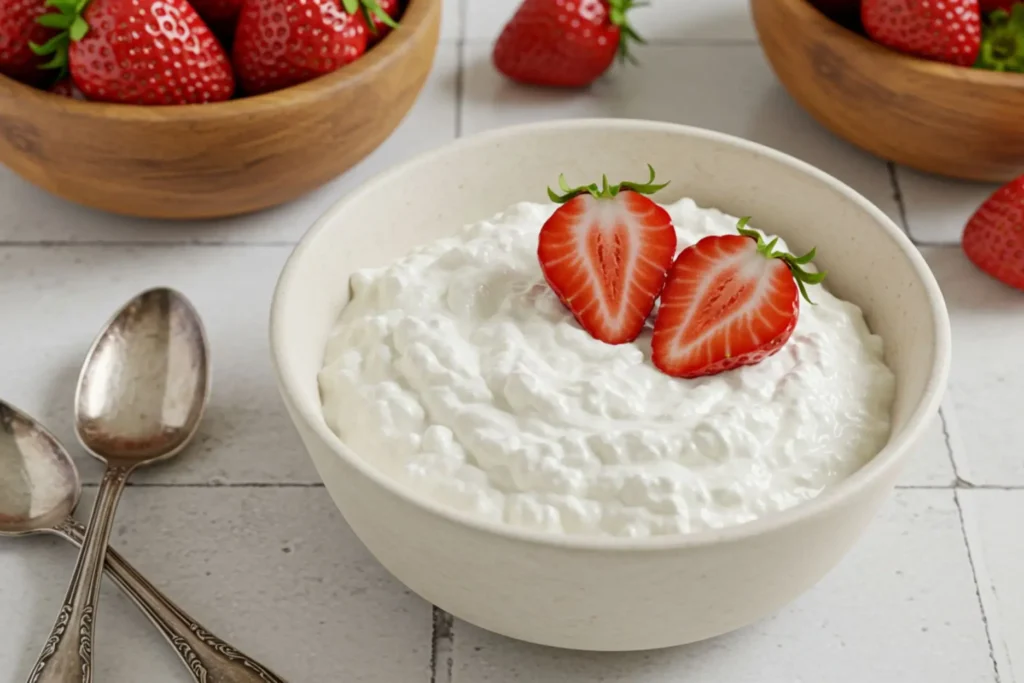
I used to think making cottage cheese at home was one of those things only grandmas or fancy chefs did. But once I tried it, I realized it’s ridiculously simple. Plus, when you make it yourself, you get to control the taste and texture—no weird preservatives or funky aftertastes. If you’ve never made your own, today is the day. Trust me, after this, you’ll never look at the store-bought stuff the same way again.
— ❖ —
Quick Guide
— ❖ —
Why Make Homemade Cottage Cheese at Home?
Aside from the fact that it tastes way better, homemade cottage cheese gives you:
- A richer, creamier texture (none of that watery mess from the store)
- Total control over the flavor and saltiness
- No additives, gums, or stabilizers—just pure, real dairy goodness
- Cottage cheese is too damn satisfying to make by hand, that’s sufficient explanation in itself. It gives me a nostalgic feeling.
— ❖ —
What You Need
Making cottage cheese is surprisingly simple. You only need:
- Whole milk – The fresher, the better. Pasteurized is fine, but ultra-pasteurized won’t work as well.
- White vinegar or lemon juice – This is what curdles the milk and gives it that signature texture.
- Salt – For flavor. If you like a creamy version, you’ll also want some heavy cream.
- Cheesecloth – To strain the curds. (If you don’t have it, a clean kitchen towel works, too!)
That’s it. No weird stuff, no complicated techniques—just simple ingredients that turn into something amazing.
— ❖ —
How to Make Homemade Cottage Cheese from Scratch
1. Heat the Milk
First, place whole milk in a large pot and heat it on medium-low until the temperature approaches 190°F. Make sure to stir every now and then so that the milk does not scorch.
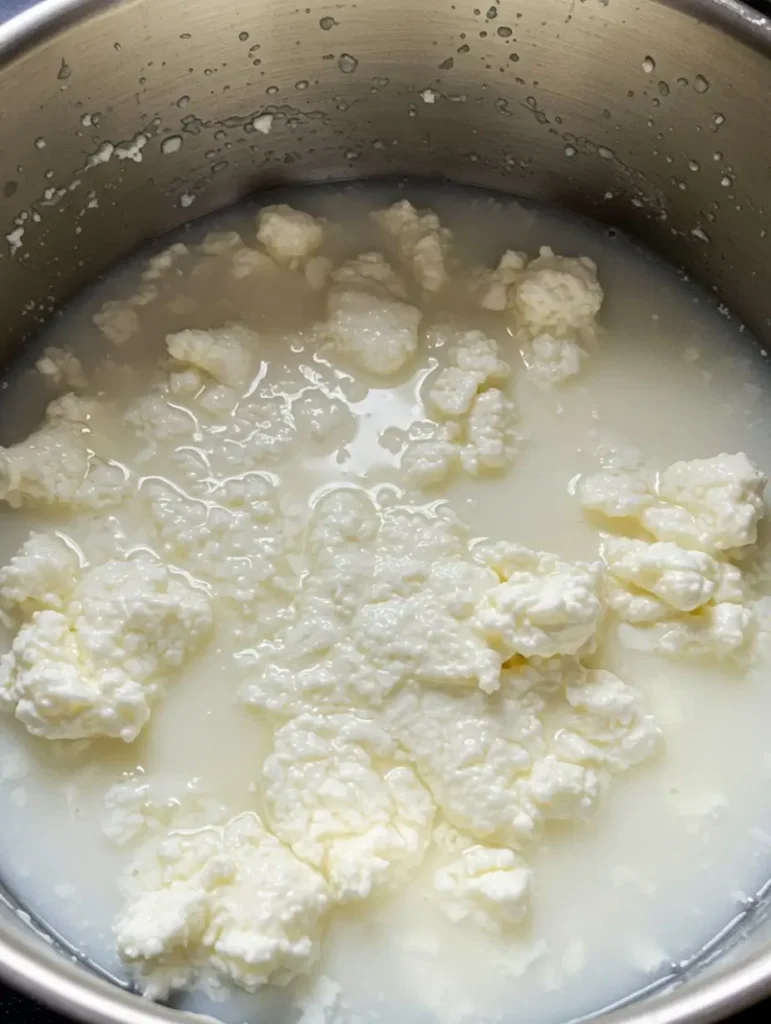
2. Add the Vinegar (or Lemon Juice)
After heating the milk, take it off the stove and gradually mix in the vinegar or lemon juice. It should start to separate immediately, with curds forming and whey (the liquid) separating. Put the lid on the pot and let it sit for 5 to 10 minutes.
3. Strain the Curds
Place the colander on top of a bowl and line the bottom of the colander with cheesecloth. More whey will come out if you pour off the milk slowly and leave the curds behind. After the curds have leaked out, allow the milk to sit for 15 minutes, or until most of the liquid has fully drained.
4. Rinse & Salt
Wring the cheesecloth into a roll and wash the curds with cold water. This stops the cooking process and any remaining acid is removed. Strain them of extra moisture and place the curds in a bowl. Season with salt to your liking, and for creaminess, mix in a bit of heavy cream.
5. Enjoy!
And just like that, you have fresh, homemade cottage cheese! Store it in the fridge and use it in everything—breakfast, lunch, snacks, or even desserts.
— ❖ —
How to Use Homemade Cottage Cheese
Now that you’ve got this fresh, creamy cottage cheese, what do you do with it? Oh, the possibilities are endless.
Breakfast Boost
- Stir it into oatmeal for extra creaminess.
- Spread it on toast with honey and berries.
- Mix it into scrambled eggs for extra protein.
Lunch & Snacks
- Use it as a dip with veggies.
- Stuff it into an avocado for a quick, healthy bite.
- Spread it on crackers with a sprinkle of black pepper.
Dinner Ideas
- Stir it into pasta for a creamy, cheesy finish.
- Use it instead of ricotta in lasagna.
- Add it to mashed potatoes for an extra rich flavor.
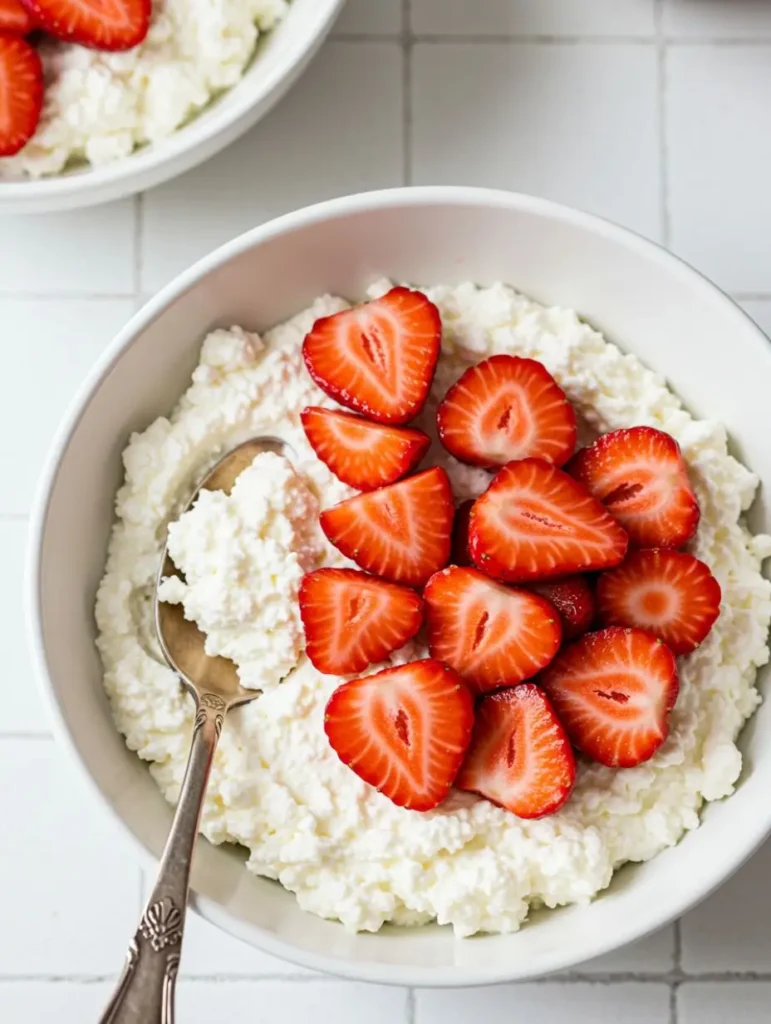
Dessert Time
How about sweet meals? You need to prepare my Blueberry Cottage Cheese Breakfast Bake with Oats, where this dish leans towards dessert. It’s perfect to eat with my oatmeal blends, and pairs well with cottage cheese, which is another great item. The whole mixture tastes delightful and is nutritious too.
— ❖ —
Tips for the Best Cottage Cheese
- Use good milk – The better the milk, the better the flavor. Avoid ultra-pasteurized if possible.
- Be patient – Letting the curds fully separate will give you the best texture.
- Experiment with flavors – Add fresh herbs, black pepper, or even a drizzle of olive oil for a savory twist.
- Store it properly – Put it in an airtight container and store it in the fridge where it can last for 5 days.
— ❖ —
What is The Most Popular Way to Eat Cottage Cheese?
Depending on one’s personal preference, the best way to eat cottage cheese is subjective, however, some classics seem to be favorites among many:
1. With Fruit & Honey
One of the most delightful ways to relish cottage cheese includes drizzling honey or maple syrup over it, some berries, banana slices or peaches as toppings. Additionally, it is incredibly mouthwatering, creamy, and filling.
2. On Toast or Crackers
Spread cottage cheese on whole-grain toast or crackers and top it with avocado, tomatoes, or even a sprinkle of everything bagel seasoning.
3. In Smoothies
For stronger proteins, include cottage cheese in your smoothies. It makes them thick, rich, and highly satiating.
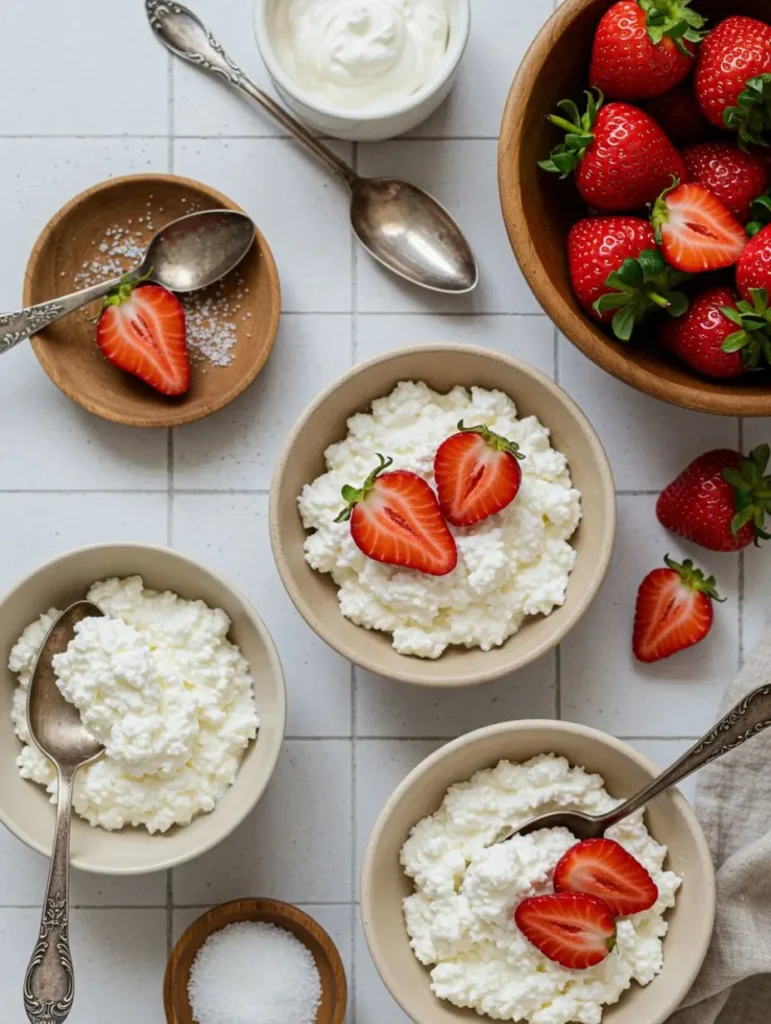
4. Mixed with Peanut Butter & Cinnamon
This may sound strange, but trust me, it is really good. A spoon of peanut butter, a dash of cinnamon, and some cottage cheese make for an astonishingly tasty combination.
5. As a High-Protein Dip
Blend the cottage cheese with ranch seasoning, mix in garlic or fresh herbs, and use it as a veggie dip or dip for chips.
6. In Scrambled Eggs
Stir it into eggs before cooking for a creamy, protein-packed breakfast.
7. As a Pasta Sauce Base
Cottage cheese can be added to sauces to give a healthy substitute for heavy cream.
Honestly, you can eat cottage cheese sweet, savory, or even by itself. It is truly that versatile!
— ❖ —
Is Cottage Cheese Healthy or not Healthy?
Cottage cheese is indeed nutritious, but as with everything, it comes down to how it is consumed and what is combined with it. That’s the breakdown:
Why Cottage Cheese is Healthy
- High in Protein – One cup has around 25g of protein, making it great for muscle building and keeping you full.
- Low in Calories – Compared to other cheeses, it’s lower in fat and calories, making it a solid choice for weight management.
- Packed with Nutrients – It’s rich in calcium, B vitamins, phosphorus, and selenium, which support bone health, energy, and immunity.
- Good for Gut Health – If you choose the probiotic kind, it can help with digestion.
Things to Watch For
- High in Sodium – Some brands have a lot of salt. If you’re watching your sodium intake, look for low-sodium versions.
- Fat Content Varies – Full-fat cottage cheese is creamy and satisfying, but if you’re limiting saturated fat, opt for low-fat or fat-free versions.
- Added Ingredients – Some flavored varieties sneak in sugar and additives—stick to plain for the best health benefits.
The Verdict?
Indeed, cottage cheese is among the super healthy food options but remember to be choosy as you combine nutritious additions such as fruits, nuts or vegetables. Just keep an eye on sodium!
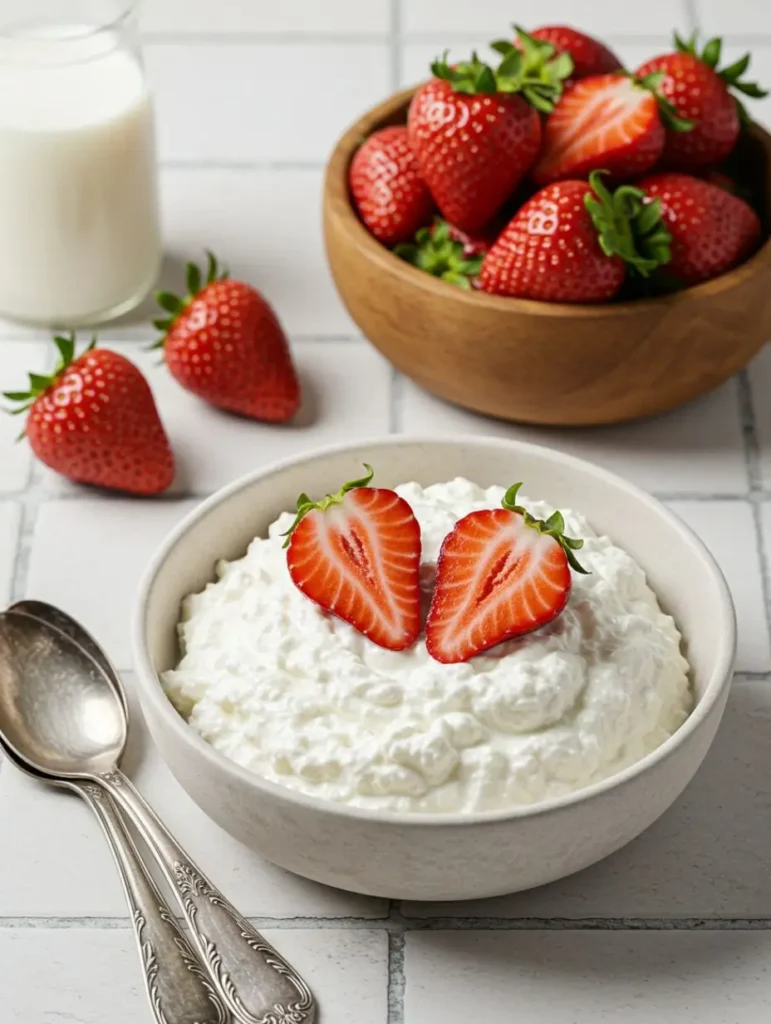
— ❖ —
Frequently Asked Questions
Q: Can I use low-fat milk instead of whole milk?
A: Indeed, but your cottage cheese will not be as creamy. It is that full satisfaction and rich texture that gives it’s mouth watering appeal.
Q: What do I do with the leftover whey?
A: Do not toss it out! You can add whey to smoothies, soups, and even bread dough. It is an excellent source of protein and offers a delicious mildque flavor.
Q: How do I make it creamier?
A: Simply add a splash of heavy cream or half-and-half after the straining step and you will be amazed at how much it improves the taste.
Q: Can I use apple cider vinegar instead of white vinegar?
A: You can, but it has a stronger taste. Stick with white vinegar or lemon juice for the best flavor.
Q: What’s the best way to eat cottage cheese for breakfast?
A: Mix it up with sweet and savory as well. Add in some honey and fruits, mix it with pancakes, or just add some black pepper along with cherry tomatoes.
— ❖ —
Reader Feedback
Diana L.“It came as a surprise to me how simple it is to prepare cottage cheese on my own! The recipe I tried was incredibly easy, and WOW! The cottage cheese turned out creamier than the ready made options. I drizzled a bit of honey and added some fresh berries. It tasted superb! I will surely make this again. It was perfect”
Caleb T.“At first, I had my doubts, but this recipe for homemade cottage cheese surpassed my expectations! The step-by-step guide really made it quite simple. I even added some of it to my scrambled eggs, and it made them really fluffy. Thank you so much for sharing this recipe.”
Your comments help us! Have you tried making this fresh and creamy homemade cottage cheese? Let us know in the comments below! We’d love to hear how it turned out for you, and your feedback helps everyone who reads them. Don’t forget to follow us on Instagram, Pinterest, and Facebook for more delicious recipes and kitchen tips!
— ❖ —
Making your own cottage cheese sounds impressive, but in actuality, it could not be more simple. Once you try real cottage cheese, it is difficult to revert to anything that is premade. Fresh cottage cheese is always a winner, whether consumed directly from the bowl, combined with a meal, or transformed into a delicious Blueberry Cottage Cheese Bake with Oats.
So go ahead, get some milk and try making it. Trust me, this creamy, homemade cottage cheese is good enough to greatly change your perception about store-bought ones. Happy cooking!
